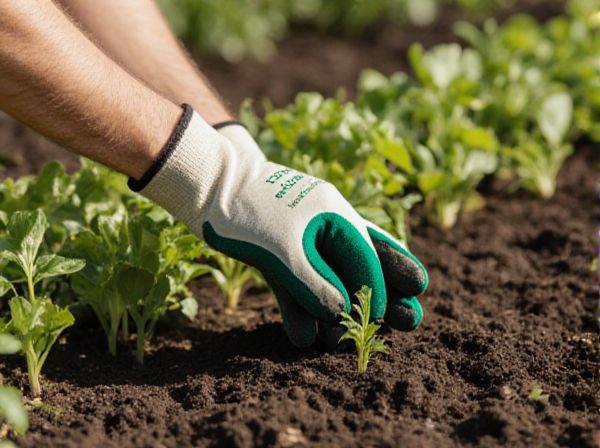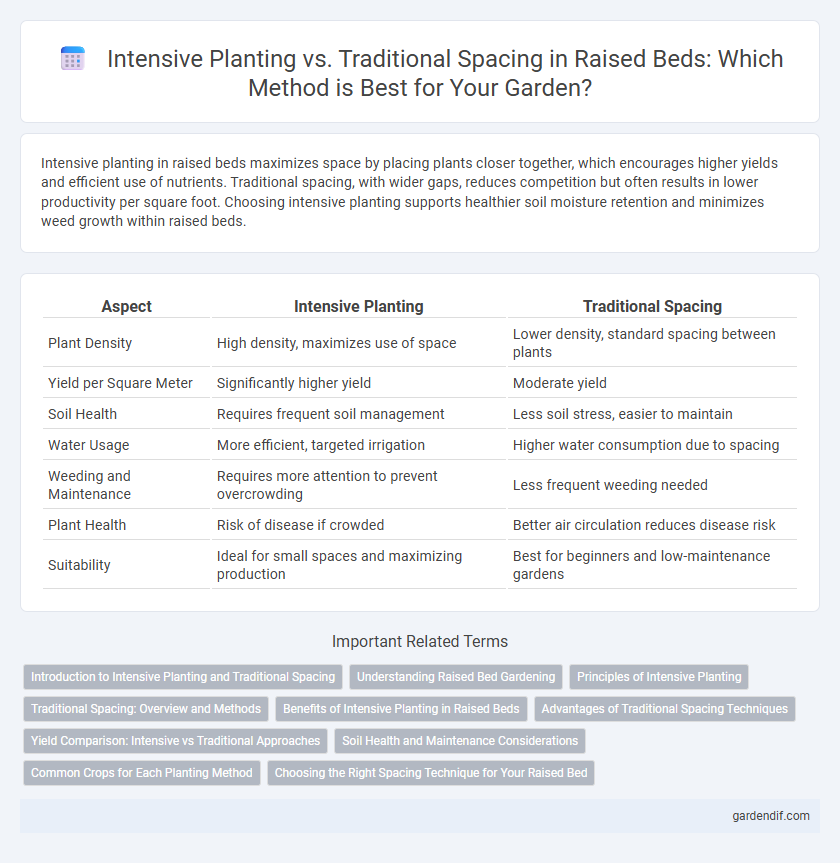
intensive planting vs traditional spacing Illustration
Intensive planting in raised beds maximizes space by placing plants closer together, which encourages higher yields and efficient use of nutrients. Traditional spacing, with wider gaps, reduces competition but often results in lower productivity per square foot. Choosing intensive planting supports healthier soil moisture retention and minimizes weed growth within raised beds.
Table of Comparison
| Aspect | Intensive Planting | Traditional Spacing |
|---|---|---|
| Plant Density | High density, maximizes use of space | Lower density, standard spacing between plants |
| Yield per Square Meter | Significantly higher yield | Moderate yield |
| Soil Health | Requires frequent soil management | Less soil stress, easier to maintain |
| Water Usage | More efficient, targeted irrigation | Higher water consumption due to spacing |
| Weeding and Maintenance | Requires more attention to prevent overcrowding | Less frequent weeding needed |
| Plant Health | Risk of disease if crowded | Better air circulation reduces disease risk |
| Suitability | Ideal for small spaces and maximizing production | Best for beginners and low-maintenance gardens |
Introduction to Intensive Planting and Traditional Spacing
Intensive planting in raised beds maximizes crop yield by reducing space between plants, enhancing resource efficiency and soil health. Traditional spacing follows wider intervals to prevent competition, but often underutilizes available bed area. Balancing plant density with species-specific needs is essential for optimizing growth and productivity in raised bed gardening.
Understanding Raised Bed Gardening
Intensive planting in raised bed gardening maximizes space by placing plants closer together, increasing yield per square foot compared to traditional spacing. This method enhances soil moisture retention and reduces weed growth by creating a dense canopy that shades the soil. Understanding the benefits of intensive planting helps gardeners optimize raised bed productivity and resource efficiency.
Principles of Intensive Planting
Intensive planting in raised beds maximizes space by closely spacing crops to enhance yield per square foot, promoting efficient use of soil, water, and nutrients. Principles include maintaining optimal plant spacing to reduce competition while ensuring adequate airflow and sunlight, using succession planting to continuously harvest, and implementing companion planting to improve growth and pest control. This method contrasts with traditional spacing by prioritizing density and productivity, which leads to healthier plants and higher overall output in a compact area.
Traditional Spacing: Overview and Methods
Traditional spacing involves placing plants at standardized distances to allow sufficient airflow and root development, reducing competition for nutrients and sunlight. Common methods include row planting and block planting, which facilitate easy access for maintenance and harvesting in raised beds. This approach enhances disease prevention and promotes healthy growth by minimizing overcrowding.
Benefits of Intensive Planting in Raised Beds
Intensive planting in raised beds maximizes space utilization by closely spacing crops, leading to higher yields per square foot compared to traditional spacing. This method enhances soil moisture retention and reduces weed growth due to dense foliage coverage, improving plant health and reducing maintenance. Raised beds with intensive planting also promote efficient nutrient use, supporting vigorous growth and more productive harvests.
Advantages of Traditional Spacing Techniques
Traditional spacing techniques in raised bed gardening promote optimal airflow and sunlight penetration, reducing the risk of fungal diseases and pest infestations. By providing adequate room for root expansion, these methods enhance nutrient uptake and soil health, leading to stronger and more resilient plants. This approach simplifies maintenance tasks like weeding and harvesting, improving overall garden productivity and longevity.
Yield Comparison: Intensive vs Traditional Approaches
Intensive planting in raised beds significantly boosts crop yield per square foot by maximizing space utilization and improving resource efficiency. Traditional spacing often leaves gaps that reduce overall productivity, whereas intensive methods enable closer plant spacing that enhances photosynthesis and soil nutrient uptake. Studies show that intensive planting can increase yields by up to 30-50% compared to traditional practices, making it ideal for maximizing output in limited gardening areas.
Soil Health and Maintenance Considerations
Intensive planting in raised beds promotes improved soil health by enhancing microbial activity and organic matter decomposition through closer root interactions and increased plant diversity. Traditional spacing often requires more frequent weeding and irrigation, whereas intensive planting reduces soil erosion and conserves moisture due to denser canopy cover. Maintenance in intensive systems demands careful monitoring to prevent nutrient depletion and pest outbreaks, but fosters a resilient, nutrient-rich soil ecosystem.
Common Crops for Each Planting Method
Intensive planting in raised beds commonly features crops like leaf lettuce, spinach, radishes, and bush beans, maximizing space with closer spacing to increase yield per square foot. Traditional spacing, preferred for crops such as tomatoes, corn, and large squash, allows ample room for root and canopy growth, reducing competition and disease risk. Understanding the growth habits and space requirements of each crop is essential to optimizing productivity in either planting method.
Choosing the Right Spacing Technique for Your Raised Bed
Intensive planting maximizes yield by closely spacing plants, enhancing soil moisture retention and reducing weed growth in raised beds. Traditional spacing offers easier access for maintenance but may underutilize available growing area. Select spacing based on crop type, growth habits, and garden management preferences to optimize productivity and plant health.
intensive planting vs traditional spacing Infographic

 gardendif.com
gardendif.com